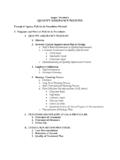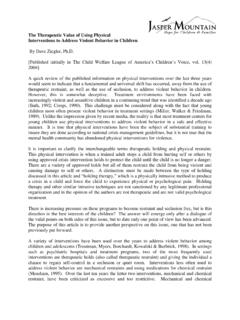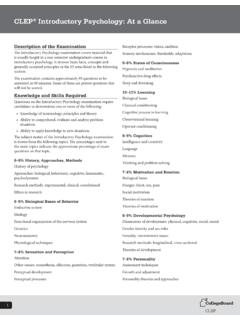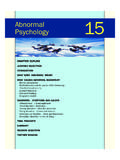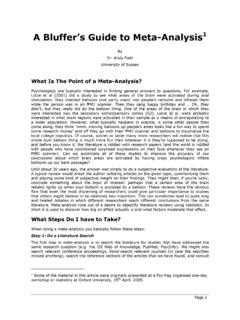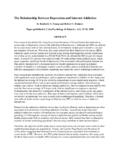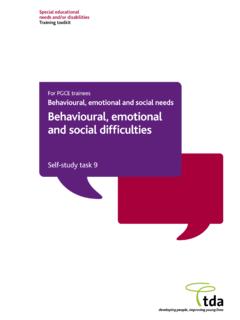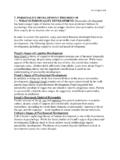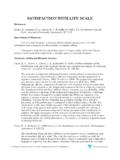Transcription of Understanding and Treating Attachments Problems …
1 Understanding and Treating Attachment Problems in Children: What Went Wrong, and How Can Problems Be Fixed Dave Ziegler, Executive Director Jasper Mountain 37875 Jasper-Lowell Road Jasper, OregonEffects of Trauma on Attachment 2 Abstract Developmental psychology, child development and clinical application with trauma have all placed important roles in a new Understanding of attachment and bonding Problems in early childhood. This article is broken into two parts. Part I discusses the important role that attachment plays in the future social success of children.
2 It explains the tenants of traditional attachment theory and how trauma affects healthy attachment. This discussion continues with revisions to attachment theory that respond to its historical weak points. A new theoretical view of attachment is proposed identifying the causes of attachment behavior. Part II turns to clinical aspects of the treatment of attachment Problems . Problems caused by trauma are identified and the many therapeutic complexities are outlined. A model for Treating attachment disturbances is proposed that discusses the clinical process in three distinct areas: disrupted attachment, anxious attachment, and no attachment.
3 The article ends with a discussion of the prognosis for a successful outcome and projects time requirements for attachment disorder therapy. Effects of Trauma on Attachment 3 Understanding and Treating Attachment Problems in Children: What Went Wrong and How Can Problems Be Fixed Introduction The study of Psychology over the last hundred years can be compared to reading a novel starting late into the book and reading progressively backwards to the beginning. Our Understanding of the complex mind and psychological make-up of Homo Sapiens has begun with adults, moved to young adults, teens, adolescents, toddlers and finally we are beginning to read with great interest the first chapters of life.
4 As we have done this over the last thirty years, there have been continuous professional awakenings occurring as the antecedents of social, mental, and moral distress begin to tell their stories in very young children. The purpose of this article is to collect the blinding flashes of insight as well as the mundane aspects of research in order to begin to tell the story of how the patterns and organization of a human personality are established in how an infant enters the stage and what happens early in the first act. The theme of a person s story and, to a large extent, the fundamental success or failure of their entire life, is established in their early attachment and bonding with their environment.
5 We are just learning to understand very early childhood and the pre cursors to social and interpersonal success or failure. This is assisting us in beginning to see clearly how patterns of dysfunction in adulthood can be casually linked to the quality of very early attachment. Part I Attachment Problems What Went Wrong How important is a secure attachment in setting the stage for personality traits and patterns of interpersonal and social success? The following quote by Mary Slater Ainsworth sums it up well: Securely attached [infants] are later more cooperative with and affectively more positive as well as less aggressive and/or avoidant toward their mothers and other less familiar adults.
6 Later on, they emerge as more competent and more sympathetic in interaction with peers. In free-play situations they have longer bouts of exploration and display more intense exploratory interest, and in problem solving situations they are more enthusiastic, more persistent, and better able to elicit and accept their mothers help. They are more curious, more self-directed, more ego-resilient and they usually tend to achieve better scores on both developmental tests and measures of language development (Ainsworth 1979).
7 Some of the most severe attachment disorders are found with abused and neglected children. The trauma of abuse produces formidable hurdles for these children to Effects of Trauma on Attachment 4 overcome. Neither the children nor society can afford for them to also have serious attachment deficits. Attachment is defined by James as a reciprocal, enduring, emotional, and physical affiliation between a child and a caregiver (James, 1994). Research with primates has shown the more advanced the species, the longer it takes to mature (Bowlby, 1982).
8 The evolutionary message encoded in this phenomenon is that Homo Sapiens not only do better in a social network, but survival itself requires sophisticated levels of social interaction for many years following birth. The natural selective process has made humankind the most dependent of creatures on one another. The social survival network that is first and foremost in importance is the attachment bond with one or more primary care providers. To facilitate this, humans have instinctual patterns leading to survival that involve social mechanisms.
9 Bowlby describes the role of instinct in the process of attachment as a complex weave of survival and adaptability combined with fixed action patterns in a feedback loop with the environment (Bowlby, 1982). Without attachment, survival is very much in doubt for one of nature s most helpless of creatures at birth. Since Bowlby s early work on attachment starting in the fifties, it has been believed that attachment and bonding may well be one of the essential keys to explaining the most fundamental psychological and social Problems . We now have significant research to confirm this global belief that a person s basic psychological disposition can be established very early in life.
10 The way a child begins to understand their surroundings, what Bowlby called inner working models, has been found to influence a child s perceptions from early childhood on into adulthood (Sroufe, 1988). An abused child may develop a working model of distrusting all relationships, a topic that will be explained further in Part II. Ainsworth s research on child abuse shows an effect abuse has on the development of a child far into the future (Ainsworth, 1978). Studies have shown that infants whose relationships with their mothers are more secure are more competent as toddlers, preschoolers and public school students (Belsky, 1988).
